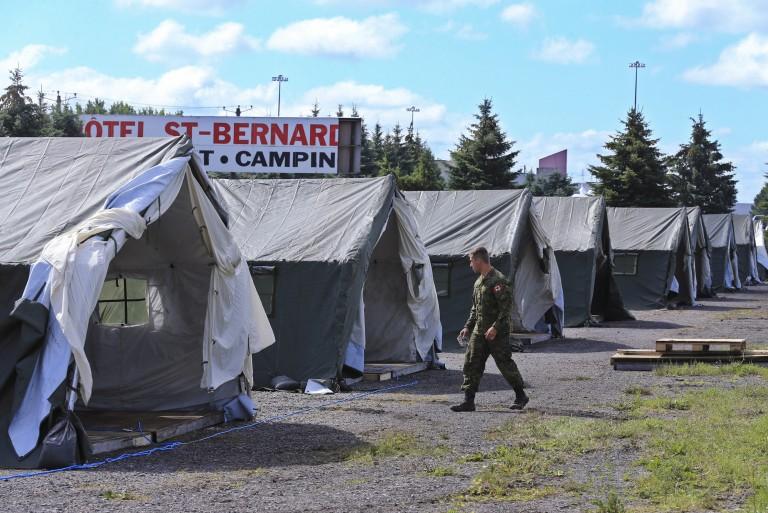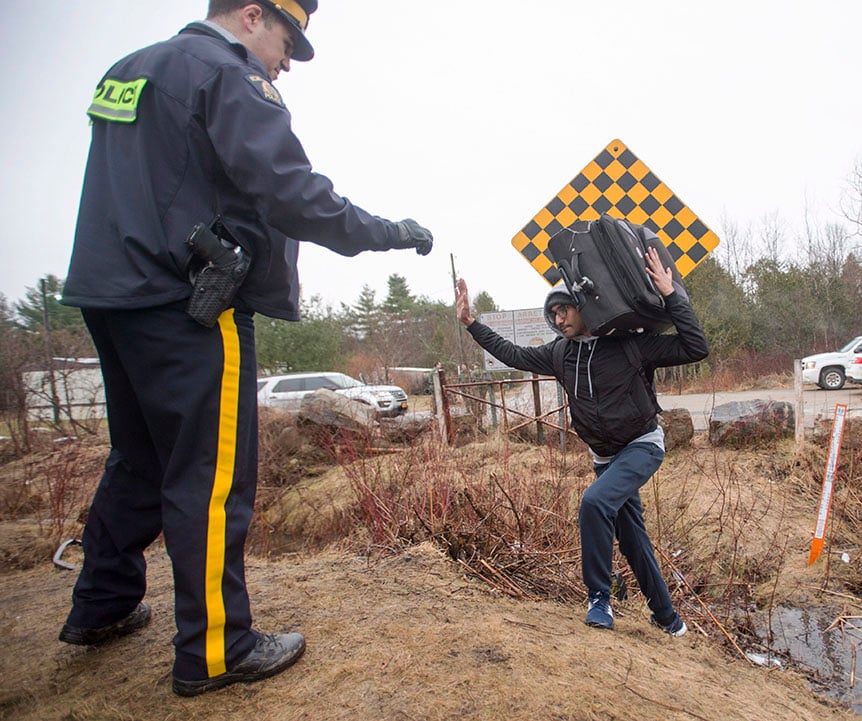How Canada can restore order to its immigration system
Opinion: Amid a new influx of migrants, there are ways for the Trudeau government to show that it has a handle on Canada’s asylum system

The migrant camp is expanded by the military located on the Canadian border on Saturday, Aug. 12, 2017. Thousands of people have crossed over into Canada from an irregular crossing near the Champlain-St. Bernard de Lacolle border in hopes of finding residency in Canada. Among them are Haitians who worry that their Temporary Protected Status in the U.S. could soon end under the Trump administration. (Al Diaz/Miami Herald/TNS via Getty Images)
Share

Howard Anglin is a fellow at the Canadian Global Affairs Institute. He was previously chief of staff to Canada’s then-immigration minister, Jason Kenney, and deputy chief of staff to prime minister Stephen Harper.
If the first part of recovery is admitting you have a problem, then the federal government made grudging progress on the migration file last week. In a series of tweets and statements, Prime Minister Justin Trudeau and Minister of Immigration Ahmed Hussen confirmed that Canada is still a country of laws and that those laws will be applied to the new wave of migrants crossing illegally from the United States. It was a start, but solving the problem will take more than words. It will take tough action of a kind that Trudeau, with his faith in the power of platitudes, has so far avoided.
Even the words, or at least the thinking behind them, will require work. Hussen’s insistence that the government was not caught off guard and Trudeau’s claim that the unprecedented numbers won’t interfere with the orderly processing of asylum claims show they still haven’t reached the step of admitting the exact nature of their wrongs.
They certainly should have been prepared. Immigration experts have warned for months that the trickle of migrants braving the Canadian winter last year would expand in the more hospitable summer months. But having to deploy the Canadian Army to build tent cities and retrofit a crumbling stadium rather belies the Minister’s claims of premonitory preparation.
And it has strained our asylum system. The Immigration and Refugee Board (IRB) is budgeted to process a little over 20,000 claims each year. Between 2015 and March of this year—that is, before this summer’s influx—the inventory of current cases in the system doubled to more than 21,000. If the current surge continues, or is repeated next summer, it will push processing times from months to years. Removals of unfounded claimants won’t happen until well after that, if ever.
Alarmingly, Trudeau and Hussen don’t seem to grasp the complexity of the problem.
There are good reasons why Haitians are leaving the United States, where they are not yet subject to removal home to Haiti, for Canada, where they are—and it can’t all be blamed on Trudeau’s infamous 2016 tweet telling would-be migrants that “Canadians will welcome you.” The main reasons are that our asylum system is tilted heavily towards claimants who would be rejected in most of our peer countries, the fact that we offer generous social benefits to both legitimate and bogus claimants from the moment they arrive until the moment they are removed, and the fact that our laws, like our border, can be ignored with minimal repercussions. This has given us the reputation as an easy mark for asylum forum-shoppers.
It is not a new problem, but until recently, our geographic isolation kept it from being a serious one. Put simply, Canada is hard to get to. Bounded by three oceans and a large absorbent southern neighbour, we could afford to be selective about who we invited to become Canadians. This allowed us to maintain among the highest levels of immigration with little of the controversy that immigration policy generates in other countries. The Canadian experience, and the secret to our globally-envied immigration and integration record, is that orderly immigration system is a healthy immigration system.
By contrast, when citizens believe that the authorities have lost control of migration flows, immigration policy becomes politically and socially toxic. We have seen this in U.S., where millions of illegal migrants have entered and established themselves recent decades, and we are seeing it again in the European response to uncontrolled migration across the Mediterranean and through the Middle East. In those countries, it is now almost impossible to have a productive discussion about regular immigration, as people are rightly focussed on the pressing crisis of irregular migration.
The all-party consensus in favour of high immigration levels can only hold as long as Canadians believe that the government has a handle on the process. When they start doubting that—and this summer has given them ample reason to be skeptical—we should expect to see the same public concern and political division over immigration policy that we see in our peer countries like the U.K., the U.S., and Australia. If the flow of asylum-seekers across our borders remains unchecked, then the majority of Canadians that polls show oppose higher levels of immigration won’t remain silent for long.
So, what can the government do to regain control? Here are some options it should consider.

First, Canada should substantially increase joint border patrols with the U.S. to apprehend people attempting to cross illegally before they can. There is a precedent for this in the Shiprider program, in which the RCMP and the U.S. Coast Guard jointly patrol smuggling in the Great Lakes. This cooperation, which was formalized as part of the 2011 Beyond the Border Action Plan by then-president Barack Obama and former prime minister Stephen Harper, should be expanded to the land border at points of frequent illegal crossing. With a border as long and porous as ours, this will never be a complete solution, but even if it only slows the flow, it would give bite to Trudeau’s currently toothless request that migrants respect our laws.
Second, the Safe Third Country Agreement (STCA) should be tightened in two ways. Under the agreement, if an asylum-seeker presents himself at a regular port of entry on the Canada-U.S. land border, we will turn him back to make his asylum claim in the United States. But if he crosses outside a port of entry—even a few hundred yards to the side—he is permitted to make his asylum claim in Canada. To remove this incentive for law-breaking, the STCA should be extended, consistent with its underlying principles, to anyone coming directly from the United States, regardless of how or where they arrived.
We should also close the loophole allowing migrants coming from the United States to make an asylum claim in Canada if they have a family member here. The definition of “family member” in the STCA is much broader than the usual definition in Canadian immigration law, including not just parents and children but also siblings, grandparents, grandchildren, aunts, uncles, nieces, and nephews. That wide net is made even wider by lax enforcement. If you turn up at the border at Windsor claiming to have an uncle in Montreal, there’s not much CBSA can do beyond making some phone calls. We rarely require strict documentary proof from both parties, let alone DNA testing, as we should (and could, without U.S. approval).
Unfortunately, the likelihood of the United States agreeing to close these loopholes is slim. Previous requests have been rebuffed, and changes that mean more people will make asylum claims in the United States rather than Canada must be about as low as you can get on the American foreign policy agenda. Still, that doesn’t mean we shouldn’t continue to ask and even to tie them to other negotiations over matters our neighbours do care about.
There are, however, two changes to the asylum system that we could make unilaterally. We could start by amending our laws to recognize American courts’ asylum decisions. Today, if an asylum seeker’s claim is rejected in the United States, he can walk across the border and make another one here. With reciprocal recognition and access to American asylum records, we could deny serial claimants a second kick at the can here. Trudeau and Hussen have recently reaffirmed their faith in the independence of the American asylum system and the idea that it satisfies Canadian standards of due process underlies the STCA. It’s time we took that idea to its logical conclusion.
The government could also copy Australia and amend the way we categorize and count refugees. Currently, the government sets annual immigration targets each year by category, which it submits to Parliament each autumn. In 2017, for example, as part of an overall total of 300,000 new immigrants, the government set a target of 25,000 for refugee resettlement and 15,000 for successful inland asylum claimants and their dependents. Unlike other immigration categories, which are within the government’s control, this last one is always an estimate. If many more asylum-seekers arrive in Canada, then we have no choice but to process them and to accept all successful claimants, even if they are over and above the stated target.
If we were to combine the two categories into a single class of humanitarian immigrants, then we could adjust the number of resettled refugees we admit each year to compensate for any inaccuracies in our estimate for the category of inland claimants. Using this year’s combined total of 40,000, if we end up accepting 20,000 asylum claims instead of the 15,000 the government predicted, we would reduce the number of overseas refugees we resettle from 25,000 to 20,000, keeping us within the overall target. If it’s not possible to be that nimble in adjusting resettlement numbers on an annual basis, then the total could be spread over two years, with next year’s number reduced instead (or increased in a year when we receive fewer successful inland asylum claims than predicted). A combined annual cap on all refugee immigration wouldn’t directly address the current flood of migrants, but it would be an important step towards regaining control over total immigration to Canada.
The government may have been slow to react to the migrant problem, but it isn’t too late for Trudeau and Hussen to restore order and reassure Canadians that our immigration system is as law-bound as they claim on Twitter. It will, however, take action as well as words. Decisive action, of the kind described above—backed up with tough words, of the kind Trudeau usually prefers to avoid.
MORE ABOUT IMMIGRATION:
- Justin Trudeau is between a rock and a heart place on immigration
- Cornwall, Ont. officials seek guidance on Haitian asylum seekers
- MP going to Miami to address misinformation among asylum seekers
- Trudeau condemns ‘racist’ rallies, urges trust in immigration system
- Number of asylum seekers at Quebec border nearly quadruples in July
- Canada’s U.S. consulates to ‘set the record straight’ on immigration
- The migrant surge on the border isn’t a crisis, it’s just a fiasco
- Canada’s immigration system is no kinder than America’s